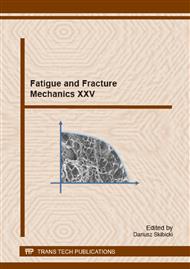[1]
D. Rozumek, Z. Marciniak, The investigation of crack growth in specimens with rectangular cross-sections under out-of-phase bending and torsional loading, Int J Fatigue 39 (2012) 81-87.
DOI: 10.1016/j.ijfatigue.2011.02.013
Google Scholar
[2]
C.M. Sonsino, Influence of material's ductility and local deformation mode on multiaxial fatigue response. Int J Fatigue 33 (2011) 930-947.
DOI: 10.1016/j.ijfatigue.2011.01.010
Google Scholar
[3]
Q. Yu, J. Zhang, Y. Jiang, Q. Li, Multiaxial fatigue of extruded AZ61A magnesium alloy, Int J Fatigue 33 (2011) 437-447.
DOI: 10.1016/j.ijfatigue.2010.09.020
Google Scholar
[4]
B.R. You, S.B. Lee, A critical review on multiaxial fatigue assessments of metal, Int J Fatigue 18 (1996) 235-244.
DOI: 10.1016/0142-1123(96)00002-3
Google Scholar
[5]
I.V. Papadopoulos, P. Davoli, C. Gorla, M. Filippini, A. Bernasconi, A comparative study of multiaxial high-cycle fatigue criteria for metals, Int J Fatigue 19 (1997) 219-235.
DOI: 10.1016/s0142-1123(96)00064-3
Google Scholar
[6]
A. Karolczuk, E. Macha, A Review of Critical Plane Orientations in Multiaxial Fatigue Failure Criteria of Metallic Materials, Int J Fract 134 (2005) 267-304.
DOI: 10.1007/s10704-005-1088-2
Google Scholar
[7]
Ł. Pejkowski, D. Skibicki, Criteria Evaluation for Fatigue Life Estimation under Proportional and Non-Proportional Loadings, Mater Sci Forum 726 (2012) 189-192.
DOI: 10.4028/www.scientific.net/msf.726.189
Google Scholar
[8]
Ł. Pejkowski, D. Skibicki, Integral fatigue criteria evaluation for life estimation under uniaxial combined proportional and non-proportional loadings, J Theor Appl Mech 50 (2012) 1073-1086.
DOI: 10.4028/www.scientific.net/msf.726.189
Google Scholar
[9]
Ł. Pejkowski, D. Skibicki, Modification of Zenner and Liu Criterion due to Non-Proportionality of Fatigue Load by Means of MCE Approach, Key Eng Mater 598 (2014) 201-206.
DOI: 10.4028/www.scientific.net/kem.598.201
Google Scholar
[10]
A. Cristofori, L. Susmel, R. Tovo, A stress invariant based criterion to estimate fatigue damage under multiaxial loading, Int J Fatigue 30 (2008) 1646-1658.
DOI: 10.1016/j.ijfatigue.2007.11.006
Google Scholar
[11]
H. Zenner, A. Simburger, On the fatigue limit of ductile metals under complex multiaxial loading, Int J Fatigue 22 (2000) 137-145.
DOI: 10.1016/s0142-1123(99)00107-3
Google Scholar
[12]
B. Li, L. Reis, M. de Freitas, Comparative study of multiaxial fatigue damage models for ductile structural steels and brittle materials, Int J Fatigue 31 (2009) 1895-(1906).
DOI: 10.1016/j.ijfatigue.2009.01.006
Google Scholar
[13]
F.C. Castro, J.A. Araújo, E.N. Mamiya, N. Zouain, Remarks on multiaxial fatigue limit criteria based on prismatic hulls and ellipsoids, Int J Fatigue 31 (2009) 1875-1881.
DOI: 10.1016/j.ijfatigue.2009.01.004
Google Scholar
[14]
M.A. Meggiolaro, J.T.P. de Castro, An improved multiaxial rainflow algorithm for non-proportional stress or strain histories - Part I: Enclosing surface methods, Int J Fatigue 42 (2012) 217-226.
DOI: 10.1016/j.ijfatigue.2011.10.014
Google Scholar
[15]
M. Kurek, T. Łagoda, Comparison of the fatigue characteristics for some selected structural materials under bending and torsion, Mater Sci 47 (2011) 334-344.
DOI: 10.1007/s11003-011-9401-x
Google Scholar
[16]
Ł. Pejkowski, D. Skibicki, J. Sempruch, High cycle fatigue behavior of austenitic steel and pure copper under uniaxial, proportional and non-proportional loading, Stroj Vestn - J Mech Eng (2014).
DOI: 10.5545/sv-jme.2013.1600
Google Scholar
[17]
T. Nishihara, M. Kawamoto, The strength of metals under combined alternating bending and torsion with phase difference, Trans Japan Soc Mech Eng 12 (1947) 44-53.
DOI: 10.1299/kikai1938.12.44
Google Scholar
[18]
A. Bernasconi, S. Foletti, I.V. Papadopoulos, A study on combined torsion and axial load fatigue limit tests with stresses of different frequencies, Int J Fatigue 30 (2008) 1430-1440.
DOI: 10.1016/j.ijfatigue.2007.10.003
Google Scholar
[19]
D.L. McDiarmid, Multiaxial fatigue life prediction using a shear-stress based critical plane failure criterion, Fatigue Des 131 (1992) 21-33.
DOI: 10.1016/0142-1123(96)81254-0
Google Scholar


